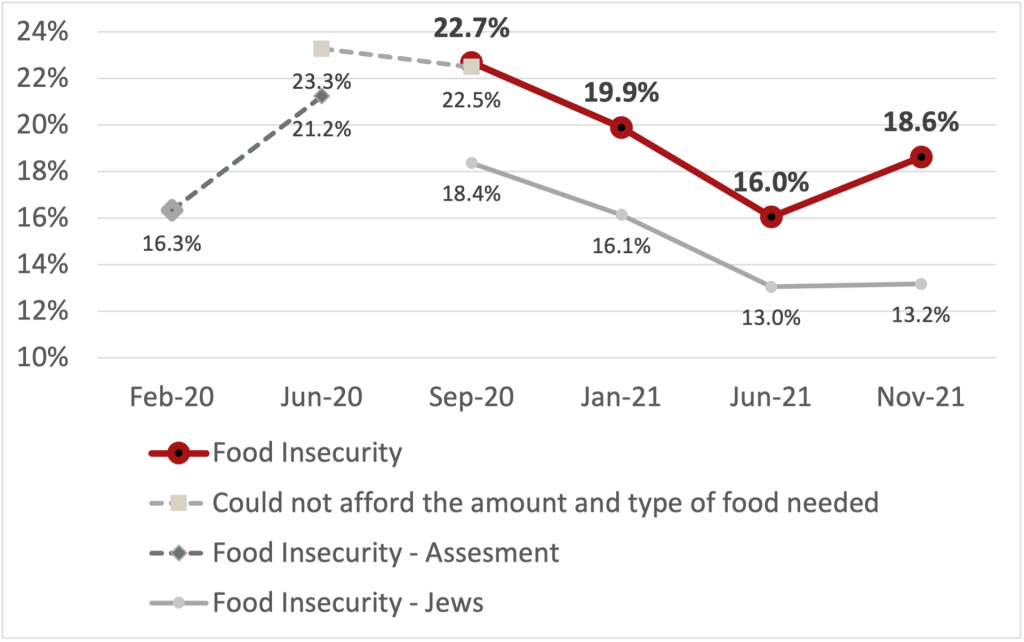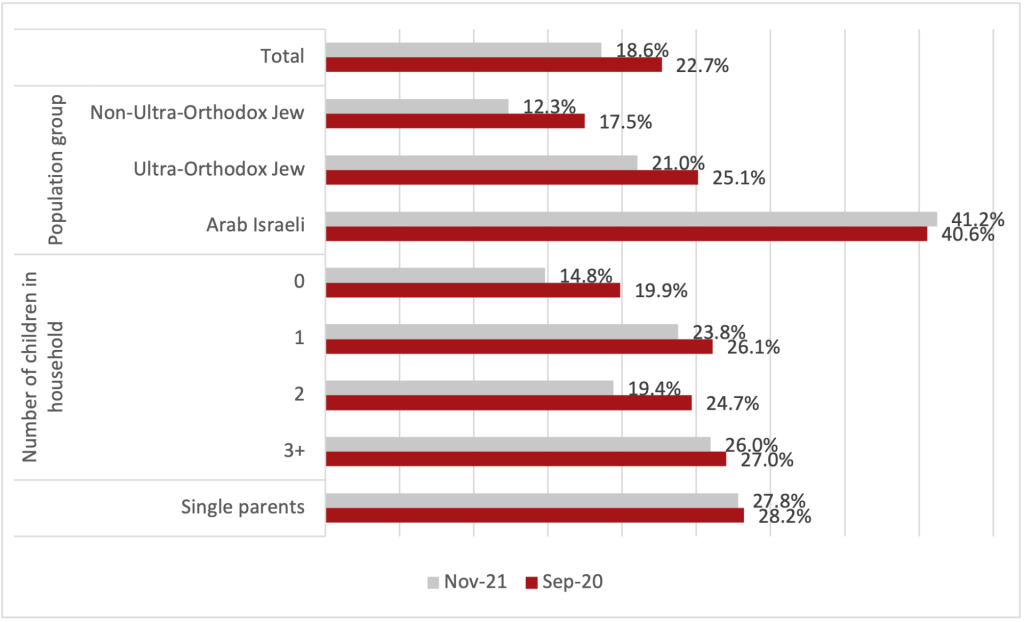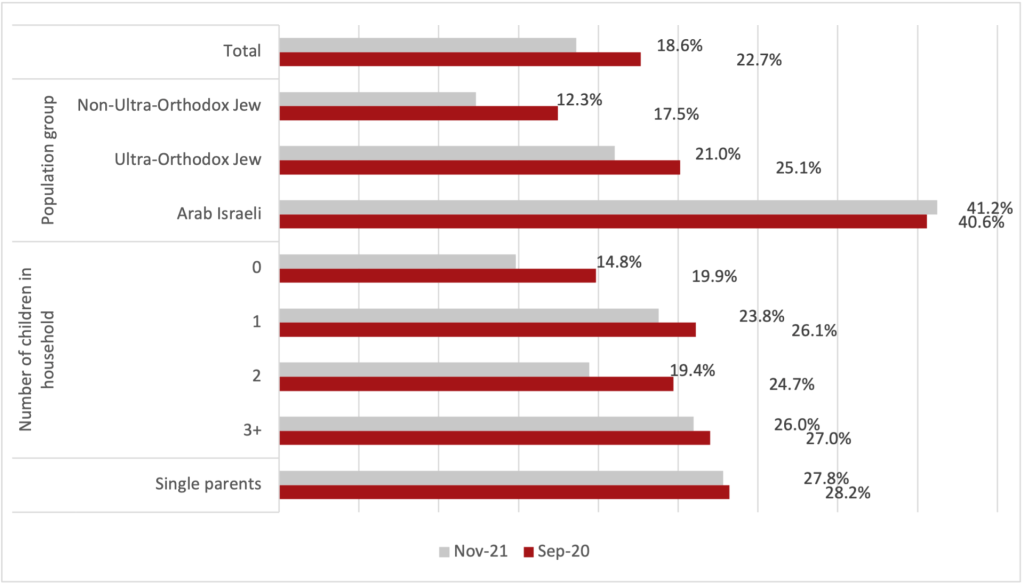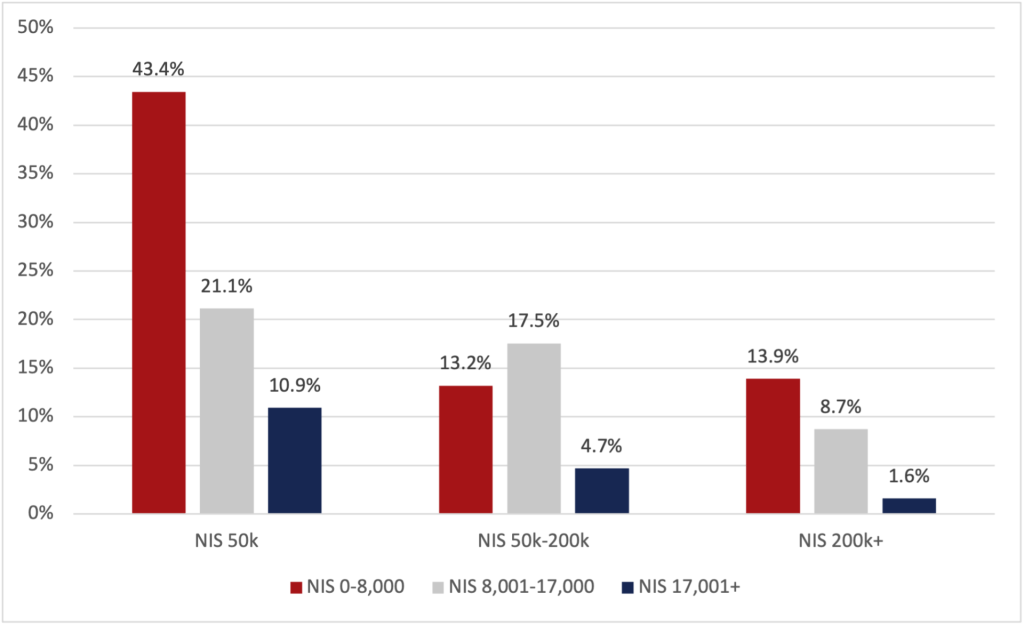By Oren Heller, research director, Israel; Yaniv Shlomo, Data Analyst, Israel; Hayley Kalb, communications assistant; Michal Grinstein-Weiss, founding director
Food insecurity is a national problem with short and long-term consequences that harm the economy and society. This problem was exacerbated by the COVID-19 pandemic, as the labor market changed, affecting the disposable income of many households. These income changes, in turn, affected the level of food security in households. This study investigates these consequences, specifically in Israel.
There is limited information about food security in Israel. The latest food insecurity survey conducted by the NII was in 2016. According to this, 17.6% of households experienced food insecurity, with a sample size of 6,226 households. More recently, Latet reported that, in September 2020, 22.6% of households experienced food insecurity, and in August 2021, 21.8% of households experienced food insecurity. Latet used the USDA’s six items for food insecurity to measure this with a sample size of 513 households.
Since both the measurement methods and sample sizes are different before and after the pandemic, we cannot draw conclusions regarding the change in food insecurity levels during the pandemic. Therefore, we have created this report to fill the information gap by reporting the changes in food insecurity levels before the pandemic outbreak, in February 2020, until about two years after the outbreak, in November 2021.
Methods
Data was obtained through a longitudinal online survey created using Qualtrics. We shared this survey with a nationally representative sample of Israeli adults 5 times throughout the COVID-19 pandemic, from June 2020 through November 2021. The objective of the study was to evaluate how socioeconomic factors affect resilience during a pandemic, and this is used to for policy research and evaluation. The sample was constructed by a local survey company, which has access to a pool of participants, and through quota sampling techniques, we ensured that the sample represented Israel’s demographic characteristics with respect to age, gender, income, and religion/religiosity.
Survey questions include inquiries about respondents’ demographic and socioeconomic characteristics and questions aimed at evaluating food insecurity. The latter was composed using a modified version of the six-items Food Security Scale (Blumberg et al., 1999), which assesses household access to food to meet their basic needs. The Food Security Scale (FSS) is included in 4 survey waves: September 2020, January 2021, June 2021, and November 2021. The FSS is not included in survey waves before and right after the pandemic outbreak.
To assess food insecurity before the onset of the pandemic, an econometric model was used. First, the model estimated the association between food insecurity, as measured by the FSS, and respondents’ sociodemographic attributes. Then, we imputed the estimated association to the respondents’ socioeconomic status, as reported before the pandemic. We used the information collected during waves 2 through 5 to estimate a logistic regression that would predict food insecurity (FI=1 if FSS>=2, and FI=0 otherwise). The independent variables used for this model are socioeconomic status, as measured by employment status and income, and demographics, as measured by age group, religion/religiosity, education level, number of children, and marital status.
For each respondent of the first wave, we used the estimated coefficients to predict two things. The first is the probability of being food insecure in June 2020, when the first wave was released. We used the respondents’ reports on the covariates listed above to do this. The second is the probability of being food insecure before the pandemic in February 2020. We used the demographic information gathered from the first wave and their socioeconomic status of in February 2020, as reported in the first wave (June 2020). The averages of the predicted probabilities are used as assessments for food insecurity in June 2020 and in February 2020.
Results
The share of Israeli households suffering from food insecurity has increased dramatically once the pandemic broke out. In February 2020, before the pandemic, the share of food-insecure households was 16.3%. By June 2020, it had increased to a number between 21.2% and 23.3%. This rate was consistently high until after September 2020. During this month, the rate was 22.7%. The rate declined to 19.9% in January 2021 and then to 16% in June 2021. In November 2021, it had risen to 18.6%. Our assumption is that this rise was due to sampling difficulties of the Arab population in Israel. In June 2021, only 7% of the sample were Arab respondents, compared to 12% and 19% in other waves. When we limited our analysis to the Jewish population only, the change in food insecurity from June 2021 to November 20201 was much smaller (Figure 1).
Figure 1: Food insecurity incidence during COVID-19

Our findings indicate that food insecurity is higher among Israeli Arabs, with a rate for this group of 41%. This rate was similar in September 2020 and November 2021. We also found that food insecurity declined among other populations (non-ultra-Orthodox: from 18% to 12%; ultra-Orthodox: from 25 % to 21%). Furthermore, food insecurity varies by family size and type. Single-parent households suffer from higher rates (28%) of food insecurity, with no change between the compared times (Figure 2).
Figure 2. Food insecurity incidence by demographic attributes, September 2020 & November 2021

Food insecurity is highly associated with other dimensions of socioeconomic status. We found that education level is associated with food insecurity levels, as food insecurity ranged from 31% among households in which the head of the household was educated at a Yeshiva or hasn’t finished high school to 11.6% among households in which the head of the household has an MA degree or higher. The households with the lowest education level experienced the lowest food insecurity reduction between September 2020 and November 2021. Employment also affects this, as the more earners (those who bring in an income) in a house, the lower the food insecurity rate. The rate was 23% in households with no earners, and 16% in households with 3 or more earners in November 2021. Low-income households[1] experience food insecurity at a higher rate, with 36% of households experiencing this in November 2021, starting from a baseline 29% in September 2020. In high-income households[2], the food insecurity rate is 6%. When we control for income, the food insecurity incidence is steady. Food insecurity is highly correlated with household savings, as the rate goes from 27% in November 2021 among households with low savings[3] to 5% among households with high savings[4] at the same point in time (Figure 3).
Figure 3. Food insecurity incidence by socioeconomic characteristics, November 2021

Once we focused on the correlations between income and savings, we saw that among households with low savings, the association between food insecurity and income is the greatest, with 43.4% food insecurity among low-income households, compared to 13.9% food insecurity among low-income households with high savings (Figure 4).
Figure 4. Food insecurity is sensitive to income, primarily among households with poor savings (November 2021)

Conclusion
As documentation of food insecurity is limited, it is difficult to find a baseline of food insecurity before the pandemic. However, using the information available, as well as developing our own models, we were able to estimate what those levels were. Using this, we can see the detrimental effects the pandemic had on food security. The rates increased rapidly and eventually decreased, but even now, we still see many incidences of food insecurity in Israel. Furthermore, it is important to note that our latest statistics are from November 2021, and it is possible that circumstances have changed in the last year. We do not know what these changes look like, highlighting the importance of collecting data regularly. Moving forward, Israel needs to continue to investigate food insecurity over time to create policies that ensure no household in Israel goes hungry. In times of hardship, these policies must be broadened to reach individuals whose rate of food insecurity has increased. With the proper support, we hope to see these rates decline.
[1] Income less than NIS 8,000 per month
[2] Income greater than NIS 17,000 per month
[3] Savings up to NIS 50,000
[4] Savings of NIS 200,000 or more